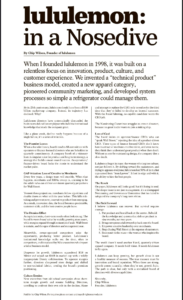The CIO role has evolved from enabling business to shaping it. As technology fuels competition and growth, CIOs are now central to boardroom discussions on revenue, customer experience and innovation. Add to the mix AI, which has the potential to drive significant cost savings by making employees more productive, helping to proactively identify and troubleshoot IT issues, and helping refine and improve revenue forecasts. This means CIOs — more than ever before — must have both a customer and profit and loss (P&L) mindset to balance how they manage IT operations and innovation to meet the goals of the business. “We are seeing an increased focus of organizations giving CIOs more responsibility to impact business strategy as well as tie it into revenue growth,” says Sal DiFranco, managing partner of the global advanced technology and CIO/CTO practices at DHR Global. He explains CIOs who are focused on technology only for technology’s sake and don’t have clear examples of business strategy and impact are not being sought after. “While innovation experience is important to have, it must come with a strong operational mindset,” DiFranco says. He adds it is critical for CIOs to understand and articulate the return on investment concerning technology investments. “Top CIOs have shifted their thinking to a P&L mindset and act, speak, and communicate as the CEO of the technology organization versus being a functional support group,” he says. Related:How CIOs Can Prepare Their Successors Reframing Company Mindsets Doug Gilbert, CIO and chief digital officer at Sutherland, explains via email that he’s reframed the company’s mindset internally by positioning technology as a revenue driver, not just a cost center. “One way we’ve done this is by categorizing revenue as digitally driven or digitally dependent versus traditional streams,” he says. This shift has transformed how teams think — prioritizing initiatives that directly impact the business — and given the company a clear metric to track year-over-year growth. “These efforts don’t just optimize processes; they deliver value that shows up on the bottom line for both Sutherland and our clients,” he says. By partnering with CMOs, COOs, and CHROs, Gilbert led the design of digital experiences that break down silos and deliver unified value, aligning technology with business goals across the organization. “This cross-functional approach has shifted our culture, embedding a revenue-focused mindset where every tech investment is tied to outcomes,” he explains. Related:Ask a CIO Recruiter: Where Is the ‘I’ in the Modern CIO Role? Anisha Vaswani, chief information and customer officer at Extreme Networks, explains this new role means not only is she responsible for driving the company’s IT strategy, but she also serves as Extreme’s “customer one”. She says it’s imperative for CIOs to communicate what they’re doing and to understand and address user concerns, otherwise they risk hindering wide adoption and limiting the success of transformation. “Clear communication of milestones is a good way to avoid an unsuccessful result,” she says. Vaswani says she prefers agile methodologies instead of a two-year program that doesn’t deliver any result until it’s fully completed. “If you can communicate incremental value — or, if that’s not practical, share milestones and progression — you can build excitement and understanding around an initiative and increase your odds of success,” she says. Setting Strong KPIs Gilbert says the greatest risk isn’t technical failure, it’s leadership misalignment. “When incentives, timelines, or metrics don’t sync across teams, even the strongest initiatives falter,” he explains. To counter this, he works to align on a shared definition of value from day one, setting clear, business-focused key performance indicators (KPIs), not just deployment milestones. Related:Tech Company Layoffs: The COVID Tech Bubble Bursts Structured governance helps, too: Transparent reporting, cross-functional steering committees, and ongoing feedback loops keep everyone on track. “These tools spark timely discussions and enable rapid course corrections when priorities shift,” Gilbert says. “Transformation isn’t about delivering tech — it’s about orchestrating change across people, processes, and platforms.” Vaswani cautions it’s easy to get caught up in a hype cycle around emerging technology, pointing to AI as a recent example. “My advice is to create a space for experimentation,” she says. “You want to enable your team to try a lot of things, because technology moves quickly, and you don’t necessarily know what will stick or produce the intended outcome.” IT leaders need room to innovate, but at the same time they must be able to fail fast and move on if something doesn’t deliver value. “Try to avoid falling in love with the technology and stay grounded in the business outcome, know what success looks like and what failure looks like, and you can speed up the process,” Vaswani advises. Smaller, High-Impact Projects DiFranco says he’s seeing a trend toward CIOs who focus on working with the business to deliver smaller, high-impact projects and early wins. “These successes lay the groundwork for overall strategy or transformation programs that earn the business trust and investment,” he explains. Vaswani adds that to stay on track, it’s important to be transparent about both successes and failures, noting not everything will work perfectly on the first try. “You can build a lot of credibility with your business partners by being honest about what’s working and what isn’t,” she says. “Clear communication and cross-functional ownership are critical to successful digital transformation.” source












